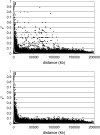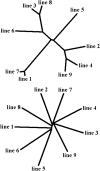Linkage disequilibrium in related breeding lines of chickens
- PMID: 17947400
- PMCID: PMC2219483
- DOI: 10.1534/genetics.107.082206
Linkage disequilibrium in related breeding lines of chickens
Abstract
High-density genotyping of single-nucleotide polymorphisms (SNPs) enables detection of quantitative trait loci (QTL) by linkage disequilibrium (LD) mapping using LD between markers and QTL and the subsequent use of this information for marker-assisted selection (MAS). The success of LD mapping and MAS depends on the extent of LD in the populations of interest and the use of associations across populations requires LD between loci to be consistent across populations. To assess the extent and consistency of LD in commercial broiler breeding populations, we used genotype data for 959 and 398 SNPs on chromosomes 1 and 4 on 179-244 individuals from each of nine commercial broiler chicken breeding lines. Results show that LD measured by r(2) extends over shorter distances than reported previously in other livestock breeding populations. The LD at short distance (within 1 cM) tended to be consistent across related populations; correlations of LD measured by r for pairs of lines ranged from 0.17 to 0.94 and closely matched the line relationships based on marker allele frequencies. In conclusion, LD-based correlations are good estimates of line relationships and the relationship between a pair of lines a good predictor of LD consistency between the lines.
Figures








References
-
- Abasht, B., and S. J. Lamont, 2007. Genome-wide association analysis reveals cryptic alleles as an important factor in heterosis for fatness in chicken F2 population. Anim. Genet. 38: 491–498. - PubMed
-
- Ardlie, K. G., L. Kruglyak and M. Seielstad, 2002. Patterns of linkage disequilibrium in the human genome. Nat. Rev. Genet. 3: 299–309. - PubMed
-
- Barrett, J. C., B. Fry, J. Maller and M. J. Daly, 2005. Haploview: analysis and visualization of LD and haplotype maps. Bioinformatics 21: 263–265. - PubMed
-
- Dekkers, J. C. M., 2004. Commercial application of marker- and gene-assisted selection in livestock: strategies and lessons. J. Anim. Sci. 82(E-Suppl.): E313–328. - PubMed
Publication types
MeSH terms
LinkOut - more resources
Full Text Sources
Research Materials

